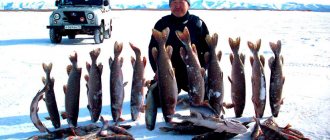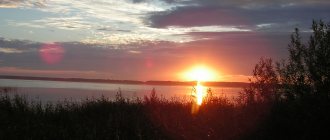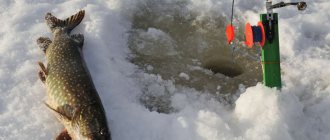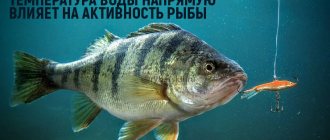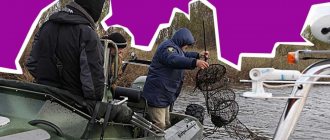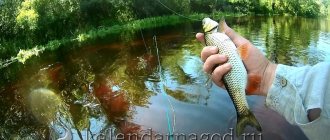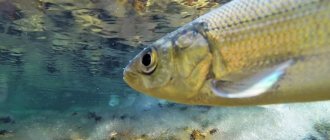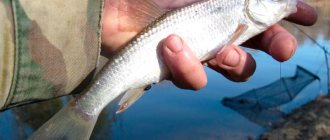Fishing in January
January is the middle of winter with all the accompanying circumstances: reservoirs are covered with ice, frost, snowfalls, and so on. However, winter fishermen are not afraid of weather conditions. Fish can be caught in winter, and the catch is quite substantial. Let's figure out what's special about fishing in January, what fish to catch in January and how. Your faithful assistants are the Fisherman's Calendar for January, the fish-biting calendar in January and the lunar calendar for January.
Where to fish in January
Experienced anglers know that fish behave differently in January. In some places the bite is active, while in others there is complete calm. The reason is simple. In small closed reservoirs, rich in aquatic vegetation, oxygen dissolved in water is much less than in large and deep ones. Oxygen is intensively consumed by the decomposing remains of plants that have sunk to the bottom; fish leave such places, and where it is impossible to leave, they die from starvation. You should especially carefully choose places for fishing in January , taking into account information about them from previous years and the current season. Preference should be given to large reservoirs and rivers that are not polluted by industrial waste.
- fishing in small reservoirs in January can leave you without a catch - in shallow, overgrown and silted reservoirs, where in winter the water is almost not enriched with oxygen, the fish becomes inactive, sick, loses appetite and does not take bait at all.
- Fishing in January on rivers and reservoirs is always productive - in deep lakes and reservoirs, mainly with clean and running water, it is easier for the fish to breathe, and they continue to feed.
When is the best time to fish in January?
Changing weather and sudden changes in temperature do not contribute to a stable fish bite in January. As the fisherman’s calendar for January emphasizes, the fish bite fades compared to December, and in some reservoirs it almost stops. On what days of the month will fishing in January be more successful? Experienced fishermen note that greater success in fishing was observed on calm, quiet days with light winds, especially after severe frosts and snowstorms.
The most favorable time for fishing in January is:
- long thaws after severe frosts;
- quiet days with stable temperatures down to -10°;
A change in bite can occur due to several factors:
- sudden change in temperature;
- drop or increase in pressure;
- when there is a strong north wind.
The lack of fish biting in January at feeding areas on certain days and even periods is associated with unfavorable meteorological conditions:
- sudden changes in barometric pressure and temperature,
- heavy rainfall,
- strong winds from the north, northeast, northwest and east.
What fish to catch in January
In lakes and reservoirs, under favorable weather conditions, perch, ruffe, roach, and bream are caught with float rods. The bite is better if you use bait (small bloodworms, crumpled boiled potatoes, various cereals, etc.). Chub can be caught in medium-flow rivers; good places are near steep banks, where the depth is 0.8 - 2 meters. The one that is least affected by the cold is the burbot. This voracious predator spawns in the cold, it is successfully caught on the bottom, and instead of bait they use gudgeon, roach, and ruff. Toothed pike are successfully caught on winter baits. On lakes and small reservoirs you should look for it at maximum depth, and on rivers and large reservoirs - in holes, depth changes, whirlpools, next to reeds, etc. In the morning at dawn and in the evening in deep and rocky places, pike perch is not bad at catching with a spoon. The spoons are narrow and medium in size. But perch prefers a small spinner or a balancer; it can be caught using a jig with or without an attachment.
Fishing in January and safety
We should not forget about this insidious phenomenon, characteristic of Russian reservoirs: during heavy snowfalls, the ice shell of rivers and lakes is covered with a thick snow cushion, the snow presses on the ice and under its weight it cracks and sinks, in such places water appears, which does not freeze under the thick - a layer of snow. Be careful! Also be careful when choosing fishing in January near populated areas. Large holes cut out and ice holes hidden under the snow are a huge danger for the fisherman. Danger awaits the fisherman in areas of the reservoir where there are springs. The ice here is thin, and under the snow layer it is not visible. River rapids with fragile ice cover can also be unpleasant. Therefore, in unfamiliar places, before taking a step, you need to check the strength of the ice with an ice pick. Previously on the topic Fishing in winter:
Fishing in January
January
- mid-winter. The ice on reservoirs is gaining the greatest thickness, blocking the access of oxygen to the water in most places. The fish begins to starve of oxygen, and it slides to those places where there is more oxygen. Closed, small reservoirs are the most problematic in terms of the presence of oxygen in the water. Therefore, for this reason, mass fish deaths most often occur in them. If possible, she goes where she is more comfortable. All this affects the peculiarities of January fishing, which always begins with the search for fish. And it requires patience and great endurance from the fisherman. In addition, as follows from practice, fishing this month is carried out with sensitive and thin gear.
Fishing for pike perch in January
You can catch this fanged predator in January. It is active throughout the winter with varying degrees of success. On the river, the favorite stopping places for pike perch are snags. He spends most of his time in a passive state, buried in the very roots, but comes out on a schedule to feed. Most often these are morning and twilight hours. The outings do not last long, but the pike perch is quite active during this period of time, and you can catch a good catch.
The situation at the reservoir is somewhat different. Here, pike perch gather in schools and move quite actively along the dumps and boundaries of holes in search of white fish. Sometimes, for a while, lingering in snags, on stumps and next to navels. Fishing in large expanses of snow, especially in January, without a motorized dog or snowmobile is very problematic.
Pike perch is very demanding on the oxygen content in water, much more than white fish, pike or perch. The higher its content, the more active the predator will be. Look for places on the pond that receive a fresh supply of oxygen.
It is best to catch it vertically using zander spoons and rattlins. Read more about this in our article - VIBs, rattlins - The best baits for trophy pike perch. It is difficult to catch it on girders; after all, searching for active pike perch involves constant movement.
Fishing in January
During this period, the amount of oxygen in the water is minimal, the fish practically does not move. It is especially difficult for it in reservoirs with dense vegetation, which begins to rot under the ice, releasing hydrogen sulfide and carbon dioxide. In closed, stagnant bodies of water, death often occurs - mass death of fish due to lack of oxygen. To avoid freezing, it is necessary to make artificial holes or holes in the ice.
When fishing during the day, it should be taken into account that large fish do not always stand in deep holes. However, it has been noticed that seasoned individuals do not like overly illuminated places; it is better to look for them under shaded steep banks, trees and bushes.
In mild winters with relatively low average temperatures, fish activity is somewhat higher. Fishing with girders, balancers and spoons can be successful. To lure medium-sized perch, it is advisable to choose a snag with a depth of 1.5–4 m, located near the shore. Areas on the border between shallows and depths can be good. In the same places you can catch pike using larger oval spoons. Pike and perch grounds are often located on tables and irrigation areas adjacent to flooded channels. Here, for each type of fish, you need to install the appropriate girders. It is better to search for a school of pike perch using the method of frontal rearrangement of the girders in the pits adjacent to the snag. Decent results are obtained by trolling with bait from a piece of fish, whitebait, or fish eye.
Using dung worms and bloodworms prepared in the fall, roach, perch, silver bream and [bream|bream] are caught with float rods. Typically, depths of more than 4 m are chosen. In clean running water, a gudgeon takes the same baits. In favorable weather, large bream bite at the exits of the pits.
Ruff, roach, perch, bluegill, silver bream, white bream, and bleak are caught using a jig with burdock moth or bloodworm larvae attached to the hook. Grayling continues to bite on a float rod and jig tipped with a worm or a bunch of bloodworms.
If the winter is cold and snowy, then don’t expect good fishing. The bite at this time is extremely unstable; the fish can make short migrations to more favorable places only in case of lack of oxygen.
On Siberian rivers the ice in January is already quite thick, and sometimes you have to work hard to cut a hole. From under the ice, grayling, nelma, lenok, taimen, and in cloudy weather - burbot are caught using a spoon.
Biting calendar for January fish
In January, fish bite differently. Not a single fish takes very well. At the same time, you can observe average bites of sorog, burbot, grayling, bream and perch. Pike perch and pike are caught even worse. Sturgeon, beluga and ruffe also bite sluggishly. And some fish simply sleep in January. Golden crucian carp, carp, and carp are in a state of hibernation. Sometimes silver crucian carp wakes up, and if January is warm, then you can see the occasional bite of carp that has woken up from unexpected warming. But for those who like to fish for trout, January is considered a good month, which can provide a rewarding catch.
As noted above, the passivity of fish is associated with a lack of oxygen in the water. This is about the same as the July heat, when all the fish were hiding from the heat in shelters and did not want to be caught even with the most tempting bait. Experienced fishermen use their tricks, developed over the years, to attract fish to bite. Firstly, they sit in a place where there is little sun and light, in the shade of tall trees or bushes, under cliffs. After all, with experience, they realized that the test fish are afraid of sunlight. Therefore, it is also advisable to dust the edges of the hole with snow. Secondly, in January you need to put the thinnest fishing line sold in the store on the reel of your winter fishing rod. Even a vein with a thickness of 0.06 millimeters will do. It will support roach, perch, dace, and bream - the most popular fish that fishermen go fishing for in the middle of winter. Perhaps the only thinner line is horsehair.
January fish are not caught in deep water. It is best to fish not in a pit, but in a pit, the mouth of a river, at the entrances to a pit. If the frosts in January are not severe, then the bites are more active. Perch is caught closer to the shore using a small spoon. They look for it near fallen bushes at a depth of two to four meters. Here, even inexperienced fishermen can catch a bag of medium-sized fish. In January, a winter fisherman tries to drill as many holes as possible in search of fish. If a spring or stream flows into a body of water, then in such a place there is usually a concentration of fish that have come to take a sip of oxygen. But you should be especially careful here because of the treacherous nature of ice. To find fish, many fishermen began to use an echo sounder. It is expensive, but quickly pays for itself, as it reliably helps determine the composition of the local ichthyofauna, its species diversity and quantity.
Bite forecast from January 1 to January 31, 2021
Successful days for fishing (good bite, quite promising fishing) 21st and 22nd lunar days
Average days for fishing (there is still a bite, but it is quite weak) 6, 7, 15, 16, 17, 18, 19, 20, 23, 24, 25, 26 and 27 lunar days
No bite (the fish are inactive, the bite is weak, almost none) 1, 2, 3, 4, 5, 8, 9, 10, 11, 12, 13, 14, 28, 29, 30 and 31st lunar day
This forecast takes into account the phase of the moon and the time of year, so the probability of the calendar is almost 100%, but you also need to take into account other factors, wind, pressure and of course the fishing location.
It is best to go fishing in the middle of winter in calm weather without wind, when frost is no more than ten degrees Celsius. If the wind blows from the north or northeast, then you should not count on a catch. January fish especially do not like gusts of wind. Pike and large perch are caught using girders placed throughout the pond at a short distance from each other. You can place many girders at once, then the chance of a trophy catch will increase. But you should study local legislation, since in some regions of our country there is a limit on the quantitative use of this gear for catching predatory fish. It is better to place the zherlitsa near the snags. After all, this is where perches and pike most often live, hunting small fish from ambush. These fish are also caught with spoons, balance beams and fishing rods.
In good weather, fishing with a winter fishing rod with a nod and a jig can give good results. Usually, January fish are finicky, so you should attach not only traditional baits in the form of a worm, bloodworm or maggot, but also give free rein to your imagination. Constant experimentation with rare baits, such as bark beetle larvae, butterflies or moths found under the bark of old trees, can bring the most amazing effect in the form of a trophy fish bite. In January, Siberian reservoirs are covered with an ice cover more than a meter thick. To drill a hole, you need to spend a lot of time and effort, using not ordinary ice drills, but motorized drills, which make the work faster. In Siberia, in the middle of winter, burbot, grayling and taimen bite well. As for taimen, it is caught by sport fishing on a catch-and-release basis, as it is a rare and endangered species of animal listed in the Red Book.
Fishing calendar in January
So, fishing in January has a number of features and the fish bite depends on many factors:
- in shallow, overgrown and silted reservoirs, where in winter the water is almost not enriched with oxygen, the fish becomes inactive, sick, loses appetite and does not take bait at all;
- in deep lakes and reservoirs, mainly with clean and running water, it is easier for fish to breathe, they continue to feed and the bite is present.
As the fishing calendar
, the fish bite in January on the right reservoirs may be absent on some days due to capricious weather:
- the fish does not take when there is a sharp drop in air pressure;
- frequent temperature changes;
- strong winds from the north, northeast, northwest direction.
Favorable time for fishing, as noted by the fishing calendar for January:
- quiet windless days (cloudy or sunny);
- thaw after snowstorms and severe frosts.
Burbot fishing in January
For burbot, January is the coolest month. When the water temperature reaches its minimum, drops below 4 degrees, it begins to spawn. The spawning period greatly depends on the region and climatic conditions. During spawning, it does not feed, but before and after it, the burbot experiences a real glutton. It is better to catch burbot using supplies, pokes, or vertical afforestation, using special tackle - a snitch. Read more about these methods of catching this river cod in the article - “Fishing for burbot. The best fishing time has come."
January in the regions
Fishing in Astrakhan
Astrakhan region of Russia
is rightfully considered a “fishing paradise”. There is no wilderness here, like central Russia. Fishing on the Volga is especially good in January in the first ten days of the month. During this period, underwater inhabitants are very active and fishermen can be content with decent catches. At this time, pike perch and perch are caught with vertical lures. During the thaw, pike are often caught on the girders. Moreover, it bites more often at night. The former “prefer” quiet-water bays. But the spotted predator is found in floodplain lakes. Here, rudd, perch, and roach actively bite on jigs.
Fishing on Akhtuba in January and on all reservoirs of the Lower Volga produces sabrefish. It is worth looking for in areas of pits where there is a reverse current. Pike perch and bersh are excellently caught. During periods of strong thaws, sheer trolling under steep steep banks can cause catfish and carp to bite. From the second ten days of January, the biting activity of all fish decreases. But not so much as to completely disappoint the fishermen. With persistence and luck, they will always come away with a significant catch. There are years when ice appears on the reservoirs of the Lower Volga only in January. In this situation, a period of clear water is promising for spinners. They catch pike perch in deep places using jigs and trolling. Moreover, large individuals are often encountered. There are known cases of trophy catfish being caught on the track.
Fishing in Karelia
Karelia has a large variety and number of rivers and lakes. There are a lot of fish in them, so the region attracts many avid fishermen. They catch it here all year round, including in winter, at its peak - in January. Winter fishing in January is characterized by a somewhat sluggish bite. This is explained by a lack of light and oxygen starvation due to a strong increase in the thickness of ice on reservoirs. In January in Karelia, pike are caught using girders and vertical lures. Mainly for large baits and at great depths. The best time for this is early morning, late evening. In large bodies of water you can catch pike perch. With bait on a float tackle, you can catch dace, gudgeon, silver bream, bream, and roach quite well. Bloodworms and worms are used as bait. The chub bites on a piece of unsalted lard in the middle reaches.
Fishing on Baikal
Until about the middle of the month, ice conditions on Lake Baikal are difficult. It's frosty outside - down to -30°C, and the surface of the water is still without solid ice. Therefore, they fish from the shore using float gear and spinning rods. In places where an ice shell has already formed, they fish through holes. Common prey are white grayling and perch. The latter reaches a weight of 2.50 kg. Later, the ice reaches a reliable thickness and allows fishermen to engage in ice fishing without fear. You can fish from ice in any part of the lake, using winter gear and any bait. The most common prey this month is grayling, sorog, perch, omul, and whitefish. The area is “famous” for strong blizzards, forcing even the most avid fishermen to stay at home. But during this period there is an “outlet” - the Selenga River, which is protected from the wind. Here you can catch a wide variety of fish.
Fishing on Seliger
Seliger is rich in fish - more than 30 species live in it. The most common species are ide, vendace, burbot, pike perch, crucian carp, roach, tench, pike, bream, catfish, smelt, perch, and gudgeon. Winter fishing in January is traditional according to the methods and gear used in the central regions of Russia. These are winter types of fishing rods equipped with jigs, spoons, and balancers. Girders are installed on the predator. They mainly catch pike, ruffe, perch, bream, and roach.
Fishing in Norway
Sea fishing is the most popular activity in Norway in January. The seas off the coast do not freeze, and you do not need to obtain a license. It is only made more difficult by harsh weather conditions. The catch is usually guaranteed and consists of cod, moth, minnow, haddock, halibut, moth, and catfish. Sometimes you come across halibut weighing more than 20 kg. They catch fish from boats and boats using vertical lures. Use bottom gear with several hooks and baits of animal origin.
Fishing in Finland
Ice fishing season continues in January in Finland. Due to the short days, large amounts of snow, and extreme cold, it is difficult. The best time for daytime fishing is a few hours around noon. They are caught on rivers, lakes, and reservoirs with winter fishing rods, spinners and jigs. At the end of the month, burbot fishing begins.
Pike fishing in January
Unlike spring fishing, fish in winter do not ask to be caught in a net and require a certain patience and skill. When fishing this way, there are a number of nuances:
- When a fish bites on this or that bait, this does not mean that it was hooked. The process of fishing is important.
- During the fishing process, you need to properly loosen the fishing line. If the fish feels weak, it can easily free itself.
- If the hook is weak or the hook is not sharp, the predator can also easily free itself.
- At the moment when the fish is near the hole, it is better to use a hook so that the tackle does not break.
- If the fish is caught on a girder, then in frosty conditions it is better to use a bright flag when biting, which will rise when the fish hits it nearby.
- It is better not to fish when the wind is north or east.
Fishing technique
- Lure fishing can be done both from the shore and from a boat. If you prefer a boat, it would be better if there were two fishermen.
- It is important that the line is always perpendicular to the water.
- Playing with bait is performed at a depth of 70 centimeters from the bottom, but first you need to examine the hole where the predator is supposed to be.
- For trolling, short fishing rods with thin lines are used.
- Lures should be small in size.
- At the beginning of winter, predators like to attach themselves to forage fish that migrate from one depth to another. And here it is important not to stay in one place, but to look for schools of forage fish.
- You should look for fishing spots using an echo sounder, or you can drill several holes in different parts of the reservoir and wait for a bite.
- Since pike is a cautious fish, you need to approach the hole as quietly as possible.
- To catch a predator, you need to choose certain hours of the day, and this, as a rule, occurs in the morning.
Features of pike fishing in January
In winter, catching pike is not so easy. Fishing is hardest in the middle of winter, especially if there are severe frosts. However, there are some positive aspects here:
- Lack of air weakens the state of the predator, and it resists less during fishing.
- Hunger forces the pike to leave its hatched holes and snags, and it rushes about in search of food.
- It is better to catch a predator in January with a regular fishing rod using crabs, poles or balancers. You can choose a fancy fishing rod for yourself, but you can get by with the simplest one - this will not affect the quality of fishing. The main thing is to choose a thin leash and a fishing line with a diameter of 0.3 mm.
- Hooking should be done quickly, because when the fish feels the balancer or other tackle, it may spit out the bait.
- The most popular baits are those whose flag goes up when bitten.
- When fishing, you should never allow the line to become loose, so as not to give the fish the opportunity to free itself.
- When the fish is near the hole, you should use waterproof gloves to avoid breaking the tackle.
- On sunny days it is worth canceling fishing, as there will be no bite on such days.
- The vents must be checked regularly, approximately every 10 minutes, and raised half a meter up. When the bait rises and falls, these movements provoke the pike to attack.
Video on catching pike in January on girders:
- In clear water, the predator attacks baits that imitate forage fish. Wobblers with a silver color are more active.
- For muddy water in a pond, it is better to use bright baits that produce certain vibrations. This game allows the fish to see food faster.
- Some anglers use wobblers that resemble pike. It all comes down to the fact that she is a cannibal and is ready to pounce on such bait.
- It is worth paying attention to the availability of equipment.
- To be sure of the reliability of the leashes, you should make them yourself from high-quality materials.
- It is important to control your gear while fishing to prevent damage to the fishing line and other attributes.
- If fishing takes place from the shore, then you need to catch fish at short distances with subsequent casts.
Fishing in January and safety
We should not forget about this insidious phenomenon, characteristic of Russian reservoirs: during heavy snowfalls, the ice shell of rivers and lakes is covered with a thick snow cushion, the snow presses on the ice and under its weight it cracks and sinks, in such places water appears, which does not freeze under the thick - a layer of snow. Be careful! Also be careful when choosing fishing in January near populated areas. Large holes cut out and ice holes hidden under the snow are a huge danger for the fisherman. Danger awaits the fisherman in areas of the reservoir where there are springs. The ice here is thin, and under the snow layer it is not visible. River rapids with fragile ice cover can also be unpleasant. Therefore, in unfamiliar places, before taking a step, you need to check the strength of the ice with an ice pick.
Fishing in January
January is a difficult month for fisherman. Despite the fact that in January, as the fisherman’s calendar says, there is a gradual increase in days, the second winter month does not please with stable weather. And this cannot but affect the fish bite in January. For the most part, fishing in January is already approaching deep winter.
January is practically the middle of winter, the reservoirs are tightly bound with thick ice. Frosts and snowstorms are a common occurrence at this time, but fishing passions have not subsided; perhaps only spinning anglers are resting.
On what days in January can you most count on successful fishing? In January, greater success in successful fishing was observed on calm, quiet days with light winds, especially after severe frosts and snowstorms.
A change in bite can occur at several points: a sharp change in temperature, a drop or increase in pressure, or a strong north wind.
The one that is least affected by the cold is the burbot. This voracious predator spawns in the cold, it is successfully caught on the bottom, and instead of bait they use gudgeon, roach, and ruff.
How the fish bite in January
Changing weather and sudden changes in temperature do not contribute to a stable fish bite in January. As the fisherman’s calendar for January emphasizes, the fish bite fades compared to December, and in some reservoirs it almost stops. The reason for this is primarily the uneven state of the aquatic environment. In small, shallow closed reservoirs, rich in aquatic vegetation, oxygen dissolved in water is much less than in vast and deep ones.
Oxygen dissolved in water is intensively consumed by the decomposing remains of dead plants that have sunk to the bottom; fish leave such places, and where it is impossible to leave, they die from starvation. You should especially carefully choose fishing spots in January, taking into account information about them from previous years and the current season. Preference should be given to large reservoirs and rivers that are not polluted by industrial waste.
In lakes and reservoirs, under favorable weather conditions, perch, ruffe, roach, and bream are caught with float rods. The bite is better if you use bait (small bloodworms, crumpled boiled potatoes, various cereals, etc.). Chub can be caught in medium-flow rivers; good places are near steep banks, where the depth is 0.8 - 2 meters.
Toothed pike are successfully caught on winter baits. On lakes and small reservoirs you should look for it at maximum depth, and on rivers and large reservoirs - in holes, depth changes, whirlpools, next to reeds, etc. In the morning at dawn and in the evening in deep and rocky places, pike perch is not bad at catching with a spoon. The spoons are narrow and medium in size. But perch prefers a small spinner or a balancer; it can be caught using a jig with or without an attachment.
Where to fish in January
The fisherman's calendar for January advises looking for fish in January in flowing reservoirs with springs, underwater springs and areas with a non-freezing water surface, with a favorable oxygen regime. Fish choose places for their stops where they can find food. In rivers with a constant flow, it also feeds in certain, limited areas (fat areas).
The lack of fish biting in January at feeding areas on certain days and even periods is associated with unfavorable meteorological conditions:
— a sharp change in barometric pressure and temperature, — heavy precipitation, — strong winds from the north, northeast and east.
When is the best time to fish in January?
The most favorable time for fishing in January is:
— long thaws after severe frosts; — quiet days with stable temperatures up to 10°.
Perch fishing in January
January perch is very capricious. It refuses to be caught in oxygen-depleted rivers and lakes. You should look for stripers near fallen logs, snags, near coastal dumps, and near accumulations of small fish. But small okushki are less demanding on the condition of the reservoir. Just as at the beginning of winter, they swim in reed thickets and in the thick of reeds.
Although fishing for such a trifle is only for a cat. And only an experienced angler can catch humpback perch in January, because where it hides and how to catch it is a difficult January task. But if the tops of sunken trees or bushes that fell into the water during a summer hurricane rise above the ice, then near this pile of wood you can find and catch a winning striped hooligan. Perch loves it when a worm, a couple of maggots or other larvae are hanging on the jig. Due to its predatory nature, it will not be caught on baits of plant origin, such as dough or bread crumbs. Some fishermen put a perch's eye on a jig or catch it with an empty jig with red hairs strung there.
You should always remember that perch only bite when actively playing with a jig and a nod. If you just put your winter fishing rod on a stand and wait patiently for the long-awaited perch to bite, you can sit until late in the evening and not see a single bite.
In the deep winter they also try to catch perch using spinners or small bright balancers. But first you need to locate the perch and stir up the fish with active action of the rod.
Angler's Calendar - JANUARY
Burbot fishing in January
Pike fishing in January
Fishing for pike perch in January
Perch fishing in January
Catching chub, roach, and bream in January
On some rivers in places with a medium current, a sandy or pebble bottom, a chub takes a small piece of unsalted lard. On quiet, windless nights, preferably during a thaw, in rivers with a smooth, not strong current, fish are caught with a flashlight. Roach, chub, white bream, and silver bream are caught with float rods using bloodworms, worms, and pieces of bird lung. The fish bite in January is improved by using bait made from small bloodworms, crushed boiled potatoes, and various cereals.
Sources:
https://www.nexplorer.ru/news__13394.htm https://fishingwiki.ru/%D0%A0%D1%8B%D0%B1%D0%B0%D0%BB%D0%BA%D0%B0_% D0%B2_%D1%8F%D0%BD%D0%B2%D0%B0%D1%80%D0%B5 https://www.fishlovlya.ru/dir/kalendar_rybolova/rybalka_v_janvare_kogo_na_chto_i_kak_lovit/2-1-0-89
In January, all kinds of fish are caught, but the most popular ones can be identified: perch, pike, pike perch, crucian carp, roach, bream. Well, in addition to those mentioned, others are also caught, depending on the reservoir. Which we will talk about in more detail in other articles.
In the first half of January, on many rivers, fish behave the same way as in December. But closer to February, the activity of the fish decreases, the bite becomes sluggish, the fish may be practically not caught, and the period of deep winter begins - the most difficult period for fishing.
In January, perch stands out against the background of other predators; it continues to be caught throughout, many fishermen do not like this, since it interrupts the bite of other types of fish.
There are several ways to catch perch in January; it can be caught using both lures and jigs. Jigs are used both reelless jigs and regular jigs with a nozzle.
The perch bite in January will primarily depend on the chosen location. At this time, you should look for perch near the holes, not in the holes themselves, but along the edges of the holes, on the edges. The perch does not go to great depths, and during periods of thaw the perch can come close to the shore.
Spoons for catching perch are usually used in small sizes, up to a centimeter wide and no more than 3 centimeters long.
To catch perch, they use reelless jigs - these are devil, uralka, goat. For bloodworm fishing for perch, drop-shaped jigs are used.
Fishing for pike perch in January.
In January, pike perch is caught using spoons. Narrow, elongated spoons are well suited for pike perch. The length of the spoon is from 5 to 7 centimeters, its width is about a centimeter. The color of the spoon for fishing in January can be either bronze or steel. Spoons of various colors are rarely used for pike perch.
In January, pike perch will finally move to greater depths; at shallow depths it will be difficult to find pike perch at this time. Usually at this time, pike perch stays near the pits, near the riverbed. In January, pike perch almost does not stand still; it actively moves around the reservoir. Usually, pike perch, when moving along a reservoir, moves along the same route from year to year, so when you come to the reservoir, you should carefully watch the local fishermen, since they already know exactly where the pike perch lives.
The technique itself for catching pike perch in January with a spoon is very good. Assembling the tackle will also not be difficult, you will need a fishing rod, preferably with a flexible whip, a fishing line with a diameter of 0.2 mm, you don’t need to use a leash, but to protect yourself in case of a pike bite, it would be better to attach a flexible and durable leash. The following can be said about the spinner game itself: the game should be active and smooth. But by no means slow, pike perch at this time is not attracted to passive prey, it needs excitement, so to speak.
If we talk about catching pike in January, it is very difficult to catch it. Pike activity at this time is almost zero. She is already quite well-fed and simply stands mostly under snags, feeding exclusively on the fish that swim in the immediate vicinity. But attracting her from afar is very difficult.
Therefore, the success of pike fishing in January will depend on how close you drill the hole and play with the bait.
You can catch pike in January either with a spoon or a balance beam. The balancer will even be more successful. Since it has a balancer, you can cover more space.
Fishing for pike using girders in January is much more successful, but we already have articles and videos about this.
Playing with bait for catching pike should be soft and smooth, so to speak, without sudden movements; pike, unlike pike perch, primarily reacts to sluggish prey.
Fishing for crucian carp in January is quite a difficult task.
In January, night fishing for crucian carp is practiced on most reservoirs, but not on all reservoirs. There are reservoirs where crucian carp are practically not caught in winter.
Well, if there is crucian carp in the reservoir, then you should look for it in areas above average, in the water areas of pits, riverbeds, and under cliffs.
Crucian carp is inactive in winter and does not particularly move around the reservoir; it plows through the silt in search of food; the main food of crucian carp at this time is bloodworms and other inhabitants of the river bottom.
In January you can catch crucian carp either with a jig or with a winter float tackle. A jig for catching crucian carp should not be large, even minimal. There is no game as such when fishing for crucian carp with a jig. You simply lower the bait with the jig to the bottom, so that the line is taut, and then from time to time lightly hit the nod with your finger, from bottom to top, and then again wait for a bite.
Fishing for roach in January
The roach bite in January can be called relatively good. Only when the weather changes can roach be caught worse.
In January, the roach finally moves to greater depths and stays exclusively in holes. The deeper the fish, the larger the fish will be; small fish usually stay on the edge of the holes.
When fishing for roach in January, the use of groundbait has proven to work especially well. The main thing in feeding a roach is not to overfeed it; the main task is to attract the roach, and not to feed it.
In January, roach is more often caught with a blood jig; here the fishing principle is similar to that of crucian carp. You simply lower the jig and bloodworm to the bottom and wait for a bite.
Well, that's all for today. And of course a couple of videos about fishing in January.
